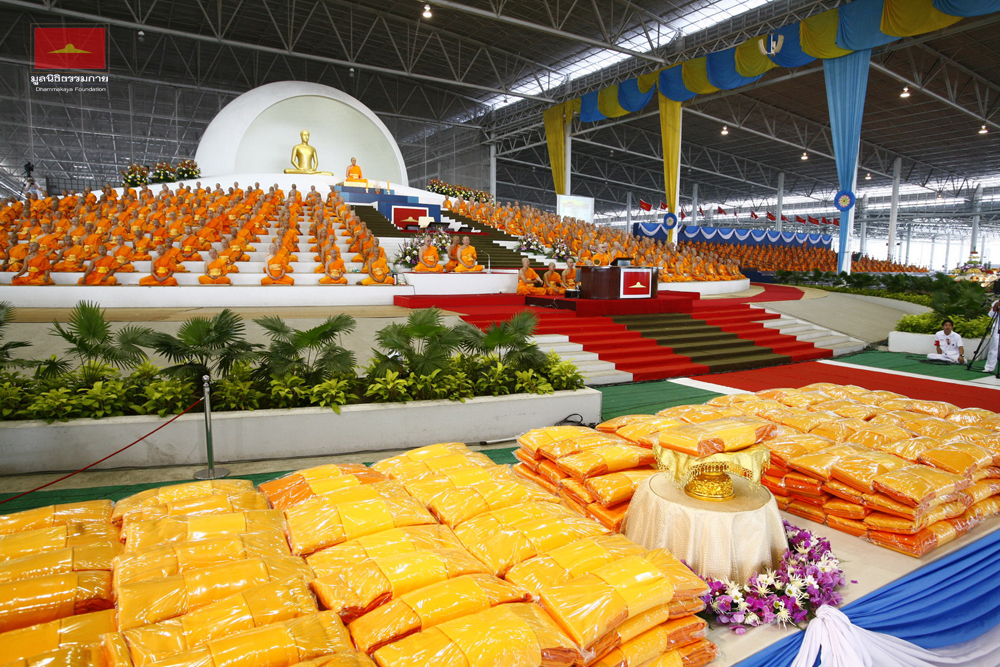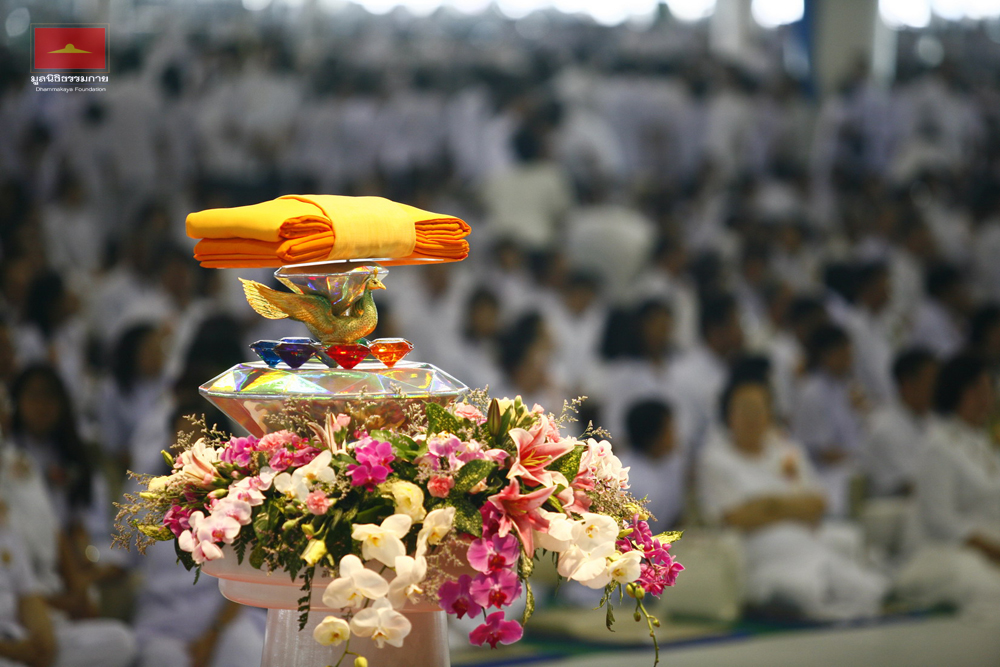Kathina-Robe Offering Ceremony 2555 B.E (2012)
The year 2555 B.E. (2012) fittingly marks the 2600th Anniversary of the Lord Buddha’s Enlightenment, and Thailand, recognized as the world’s center for Buddhism, has been honoring this sacrosanct and monumental anniversary throughout this year.
The august celebration is conducted to commemorate the three important events associated with the Lord Buddha –His Birth, Enlightenment, and Entering into Nibbāna – all of these events occurred on the 15th day of the sixth waxing moon, or Vesak Day. This year Vesak Day was celebrated on 4th June 2555 B.E. (2012).
As Buddhism approaches the 26th century of the Buddhist Era, Buddhists continue to gather and encourage people to perform wholesome deeds and to cultivate virtues throughout each year as homage to the Lord Buddha. The end of this Buddhist Lent will be yet another occasion to accumulate immense merit from the Kathina Ceremony and dedicate it to the Lord Buddha.
"Kathina," a term rooted in ancient Pali language, has its literal meaning of embroidery frame. Presentation of "Kathina" however refers to the annual ceremonial offering of robes or robe cloth - rather than the sewing tool itself – to the Buddhist monastic community. Indeed, the Buddhist tradition of offering Kathina robe traces its origin to the Lord Buddha's time when a group of Buddhist monks set out on a pilgrimage from their home town in Patiala to attend an audience with the Lord Buddha at Jetavana Monastery. The trek, which spanned through to the monsoon season, had sapped their robes thread by thread that each turned muddy, rain-soaked and battered by the time the pilgrims reached the monastery. For this reason, the Lord Buddha granted His permission that this group of Patiala pilgrims as well as the rest of the monastic community who had observed Buddhist Lent (a pledge to reside in a single place for the entire three months of the monsoon season) be presented with new robes or robe cloth by lay supporters at the end of the period. This practice of robe offering thus commenced and has become a tradition in our days, where alms may encompass not only the robes or robe cloth but also a variety of additional gifts such as monetary contributions, flowers and assorted consumption commodities.
Lay supporters are eligible to present Kathina robes to the Buddhist monastic community that comprises a minimum of five members who each have strictly observed Buddhist Lent as a way to increase their Dhamma knowledge, cultivate virtues and further their practice meditation. Accepted as a common item, the Kathina robes shall be formally decided upon amongst the community and then bestowed to its one designated member. Any lay supporters - individually or in group with a delegate - may initiate a proposition to offer the Kathina robes.
Special Merit for a Special Occasion
The wonderful tradition of Katina-Robe Offering has been performed consistently since the time of the Lord Buddha. The merit gained from Kathina is considered exceptional since it does not occur easily given that there are many requirements. For instance, there is a time limit – it has to be completed within a month after the end of Buddhist Lent. Thus, Kathina-Robe Offering cannot be performed whenever one wishes. This year’s Kathina is especially distinguished than any other year because it perfectly commemorates the 2600th anniversary of the Lord Buddha’s Enlightenment. If this opportunity is missed, one would have to wait another 100 years before the next centennial arises.
Buddhajayanti: The Supreme Victory
The word ‘Buddhajayanti’ comprises of the words Buddha that refers to the Lord Buddha and ‘jayanti’ that comes from the word ‘jaya,’ meaning victorious. Combined, Buddhajayanti refers to the supreme victory of the Lord Buddha over Mara and all the defilements.
Additionally, Buddhajayanti is the declaration of victory for all Buddhists as well. Once the grand Kathina ceremony – celebrating the supreme triumph by the Lord Buddha – is complete, one should make an earnest wish that the merits gained from this virtuous activity bring happiness, health, and prosperity to us and our family; help us be replete with wealth and resources; and provide us the resolve to overcome all the obstacles in every lifetime until we enter Nibbāna.
The Fruit of Merit from Offering Kathina-Robe
Kathina-Robe Offering is considered one type of offerings because the offering can be made to the monastic community without specifying any one monk in particular. The fruit from this merit is tremendous—as the Lord Buddha expounded in one of His teachings that sanghadāna, or the offering of alms, yields positive consequences for the donor. In other words, those who wish to acquire a great source of merit should perform wholesome deeds with the monastic community.
Therefore, everyone is cordially invited to participate in the Kathina-Robe Offering Ceremony at the Dhammakaya Temple, where over 2000 venerable monks and novice monks who have earnestly observed Buddhist Lent for the past three months will act as our fertile fields of merit.
Kathina-Robe Offering Ceremony 2555 B.E (2012)
A Commemoration of the 2,600th Anniversary of Lord Buddha’s Enlightenment
Sunday, 4th November 2555 B.E (2012)
Morning Session
| 06.30 am | Alms Offering Ceremony |
| 09.30 am | Morning Meditation/ Ceremonial Food Offering to the Lord Buddha |
| 11.00 am | Offering of Midday Meal |
Afternoon Session
| 13.30 pm | Kathina-Robe Offering Ceremony/ Afternoon Meditation |
| 15.30 pm | End of the Kathina Ceremony |
| 18.00 pm | Ceremonial Acceptance of the Kathina-Robe by the Monastic Community |



